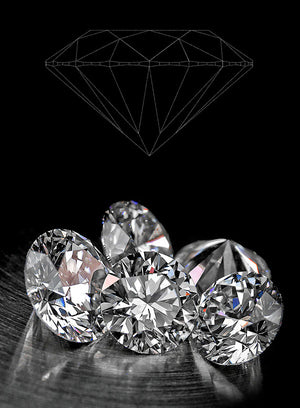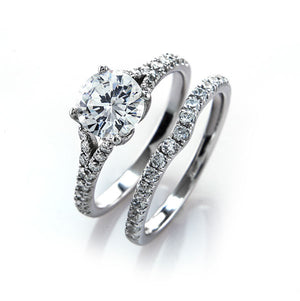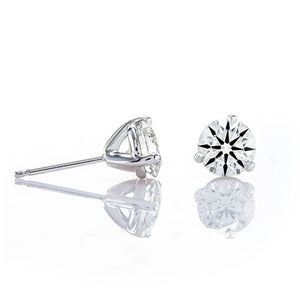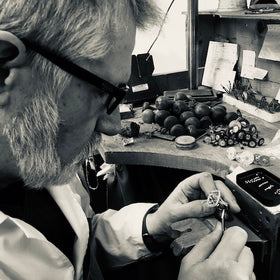"I’m shopping for a diamond for an engagement ring. You’re shocked to discover that, I’m sure. But this is kind of a big deal for me, buying an engagement ring represents one of the biggest expenditures of my young life. I don’t own a house yet, and am driving a hand-me-down car, and now I’m supposed to plunk down three months’ salary on a diamond. Well the jokes on you De Beers, because I’m still in college. Perhaps that 2-3 month salary rule should be adjusted to include my student loans? In the meantime, can you explain what is the XXX diamond grade? My older brother just bought a XXX diamond for his engagement ring and told me to settle for nothing less. As usual, he couldn’t tell me why. He just said that he’s done all this research, and that’s what I should buy also. Typical.”
(Updated: July 27, 2021. Original Publish Date: Dec. 26, 2016)
The GIA XXX cut grade:
“GIA-XXX” is a common abbreviation used to refer to diamonds graded by the GIA Gem Trade Laboratory with an overall cut grade of GIA Excellent. The GIA-GTL or just plain old “GIA” as it is commonly referred to, bases the overall cut grade of a diamond on three factors:
- Polish
- Symmetry
- Proportions
When a diamond receives the individual grade of excellent for all three factors of cut grade, it receives the overall cut grade of GIA Excellent.
Thus, a GIA graded diamond that receives grades of excellent for polish, symmetry, and proportions is deemed to be GIA Excellent. Diamonds with an overall cut grade of GIA Excellent are commonly referred to as “GIA Excellent cut diamonds” and further abbreviated as GIA 3X, Triple X, or XXX as you’ve pointed out.
Click here to search for over 15,000 GIA XXX Diamonds
Is GIA Excellent the best-cut diamond?
I have an older brother also, and in the spirit of sibling rivalry, I want to share with you the reasons why I prefer the American Gem Society Laboratory over the GIA-GTL. However, with the understanding that I find the grading standards of both laboratories to be comparable for the basics, such as:
However, I feel that the GIA-GTL falls short when it comes to judging the light performance of a diamond. This is because the GIA Laboratory does not take the actual light performance of diamonds into account as part of their grading process… but the AGS Laboratory does. This is why Brian Gavin chooses to send their diamonds to the AGSL for grading.
How the AGSL measures Light Performance:
The American Gem Society Laboratory uses a proprietary technology known as ASET to determine the light performance of diamonds. ASET is an abbreviation for Angular Spectrum Evaluation Technology. The red, green, and blue colored image of a diamond that appears in the face-up position on the diamond grading report to the left, is the ASET image for this
1.330 carat, G-color, VS-2 clarity, Black by Brian Gavin round hearts and arrows diamond.
This diamond has an overall cut grade of AGS Ideal-0, which means that it received an Ideal-0 rating for Polish, Symmetry, Proportions, and Light Performance. The highest rating available from the AGSL.
I have no doubt that this diamond would receive an overall cut grade of GIA Excellent if we submitted it to the GIA Gem Trade Laboratory for grading. However, only the AGS Laboratory can provide you with the additional insight offered by ASET.
GIA Excellent vs AGS Ideal-0 (sibling rivalry)
You might not be aware of this, but the GIA and AGS are siblings of sorts. Both organizations were started by Robert M. Shipley, however, we all know that siblings often feel the need to do things their own way.
On that note, you might want to ask your brother about the ASET scope image for his GIA Excellent cut diamond. Before you do, you’ll want to read this tutorial that explains
what the different colors of an ASET mean.
I’d love to be a fly on the wall for this conversation. Of course, if your brother purchased his GIA Excellent cut “XXX diamond” from a reputable vendor like Brian Gavin, he might actually have an ASET Scope image available. We have the capability in-house to photograph diamonds through an ASET Scope, as well as a Hearts & Arrows viewer, and an Ideal Scope. Which is why we provide these reflector scope images on the diamond details pages of all
Brian Gavin Signature diamonds.
Click here to search for over 15,000 GIA XXX Diamonds or Discover the perfection of Brian Gavin's AGS 000 Super Ideal Hearts and Arrows Diamonds
Diamond Proportions and Optical Precision:
 You might be aware that the proportions of a diamond dictate the volume of light return and the balance of brilliance and dispersion. As a matter of fact, we think that the range of proportions allocated for the GIA Excellent Cut rating is too broad. This means that a lot of GIA Excellent cut diamonds are cut to proportions that are well beyond our preferred range.
With this in mind, while shopping for a diamond, we recommend that you look for options that have proportions right in the middle of the spectrum that is designated as “the sweet spot” or target zone for diamond cutters like Brian Gavin.
Although this may be true, the reality is that a lof of round brilliant ideal cut diamonds with proportions within this center range still leak a substantial amount of light because the degree of optical precision is lacking.
To be perfectly clear, the term optical precision refers to the consistency of facet shape, size, and alignment as the facets are polished onto the surface of the diamond from the perspective of 360-degrees. The hearts pattern pictured to the left reflects the higher degree of optical precision exhibited by Brian Gavin Signature diamonds.
You might be aware that the proportions of a diamond dictate the volume of light return and the balance of brilliance and dispersion. As a matter of fact, we think that the range of proportions allocated for the GIA Excellent Cut rating is too broad. This means that a lot of GIA Excellent cut diamonds are cut to proportions that are well beyond our preferred range.
With this in mind, while shopping for a diamond, we recommend that you look for options that have proportions right in the middle of the spectrum that is designated as “the sweet spot” or target zone for diamond cutters like Brian Gavin.
Although this may be true, the reality is that a lof of round brilliant ideal cut diamonds with proportions within this center range still leak a substantial amount of light because the degree of optical precision is lacking.
To be perfectly clear, the term optical precision refers to the consistency of facet shape, size, and alignment as the facets are polished onto the surface of the diamond from the perspective of 360-degrees. The hearts pattern pictured to the left reflects the higher degree of optical precision exhibited by Brian Gavin Signature diamonds.
Creation of Hearts Patterns in Round Diamonds:
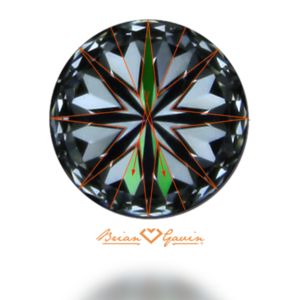 As a matter of fact, it takes the combined efforts of five different facet sections to create the hearts pattern exhibited by Brian Gavin Signature diamonds.
The image on the left shows the main pavilion facets outlined in orange in the 12 o’clock position. The light reflects off of that facet and travels across the diamond where it reflects off of the lower girdle facets in the relative six o’clock position.
The steeper angle of the lower girdle facets causes the new forming heart to separate from the arrowheads that are visible in the middle of the diamond.
In order for each of the hearts to be consistent in size and shape, a total of 5 different facets must work in perfect harmony. Specifically, light reflects off of 2 pavilion main facets, 2 lower girdle facets, and 1-star facet from the crown section to create each heart.
The pattern of eight hearts is created as light reflects off of all the facets of the diamond within those sections all the way around the stone. If there is any difference in the shape, size, or alignment of the facets, then it will be apparent in the heart's pattern as an inconsistency.
As a matter of fact, it takes the combined efforts of five different facet sections to create the hearts pattern exhibited by Brian Gavin Signature diamonds.
The image on the left shows the main pavilion facets outlined in orange in the 12 o’clock position. The light reflects off of that facet and travels across the diamond where it reflects off of the lower girdle facets in the relative six o’clock position.
The steeper angle of the lower girdle facets causes the new forming heart to separate from the arrowheads that are visible in the middle of the diamond.
In order for each of the hearts to be consistent in size and shape, a total of 5 different facets must work in perfect harmony. Specifically, light reflects off of 2 pavilion main facets, 2 lower girdle facets, and 1-star facet from the crown section to create each heart.
The pattern of eight hearts is created as light reflects off of all the facets of the diamond within those sections all the way around the stone. If there is any difference in the shape, size, or alignment of the facets, then it will be apparent in the heart's pattern as an inconsistency.
Why Brian Gavin Says “It’s all in the hearts”:
The presence of a crisp and complete pattern of hearts in a round or cushion cut diamond indicates a higher degree of optical precision. While that is all well and good, you might be wondering why it’s important for a cushion or round brilliant cut diamond to exhibit a hearts pattern. After all, it’s not like you’re going to be able to see the hearts pattern once the diamond is set in a ring, am I right?
Well, the reason why it’s important for a round or cushion cut diamond to exhibit a crisp and complete pattern of hearts is that it indicates a higher degree of optical precision. Now, before you think that I’m talking in circles, I’ll explain why that is important.
The higher degree of optical precision will increase the volume of light return (reduce light leakage) and produce a higher number of virtual facets within the diamond. That means that the facet structure will produce more reflections of light within the diamond and that spiraling kaleidoscope effect will produce outward sparkle that is more vivid and intense.
Click here to search for over 15,000 GIA XXX Diamonds or Discover the perfection of Brian Gavin's AGS 000 Super Ideal Hearts and Arrows Diamonds
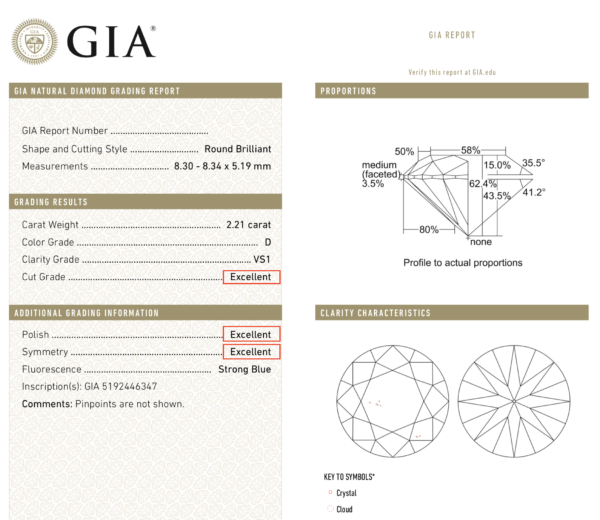
 You might be aware that the proportions of a diamond dictate the volume of light return and the balance of brilliance and dispersion. As a matter of fact, we think that the range of proportions allocated for the GIA Excellent Cut rating is too broad. This means that a lot of GIA Excellent cut diamonds are cut to proportions that are well beyond our preferred range.
With this in mind, while shopping for a diamond, we recommend that you look for options that have proportions right in the middle of the spectrum that is designated as “the sweet spot” or target zone for diamond cutters like Brian Gavin.
Although this may be true, the reality is that a lof of round brilliant ideal cut diamonds with proportions within this center range still leak a substantial amount of light because the degree of optical precision is lacking.
To be perfectly clear, the term optical precision refers to the consistency of facet shape, size, and alignment as the facets are polished onto the surface of the diamond from the perspective of 360-degrees. The hearts pattern pictured to the left reflects the higher degree of optical precision exhibited by Brian Gavin Signature diamonds.
You might be aware that the proportions of a diamond dictate the volume of light return and the balance of brilliance and dispersion. As a matter of fact, we think that the range of proportions allocated for the GIA Excellent Cut rating is too broad. This means that a lot of GIA Excellent cut diamonds are cut to proportions that are well beyond our preferred range.
With this in mind, while shopping for a diamond, we recommend that you look for options that have proportions right in the middle of the spectrum that is designated as “the sweet spot” or target zone for diamond cutters like Brian Gavin.
Although this may be true, the reality is that a lof of round brilliant ideal cut diamonds with proportions within this center range still leak a substantial amount of light because the degree of optical precision is lacking.
To be perfectly clear, the term optical precision refers to the consistency of facet shape, size, and alignment as the facets are polished onto the surface of the diamond from the perspective of 360-degrees. The hearts pattern pictured to the left reflects the higher degree of optical precision exhibited by Brian Gavin Signature diamonds.
 As a matter of fact, it takes the combined efforts of five different facet sections to create the hearts pattern exhibited by Brian Gavin Signature diamonds.
The image on the left shows the main pavilion facets outlined in orange in the 12 o’clock position. The light reflects off of that facet and travels across the diamond where it reflects off of the lower girdle facets in the relative six o’clock position.
The steeper angle of the lower girdle facets causes the new forming heart to separate from the arrowheads that are visible in the middle of the diamond.
In order for each of the hearts to be consistent in size and shape, a total of 5 different facets must work in perfect harmony. Specifically, light reflects off of 2 pavilion main facets, 2 lower girdle facets, and 1-star facet from the crown section to create each heart.
The pattern of eight hearts is created as light reflects off of all the facets of the diamond within those sections all the way around the stone. If there is any difference in the shape, size, or alignment of the facets, then it will be apparent in the heart's pattern as an inconsistency.
As a matter of fact, it takes the combined efforts of five different facet sections to create the hearts pattern exhibited by Brian Gavin Signature diamonds.
The image on the left shows the main pavilion facets outlined in orange in the 12 o’clock position. The light reflects off of that facet and travels across the diamond where it reflects off of the lower girdle facets in the relative six o’clock position.
The steeper angle of the lower girdle facets causes the new forming heart to separate from the arrowheads that are visible in the middle of the diamond.
In order for each of the hearts to be consistent in size and shape, a total of 5 different facets must work in perfect harmony. Specifically, light reflects off of 2 pavilion main facets, 2 lower girdle facets, and 1-star facet from the crown section to create each heart.
The pattern of eight hearts is created as light reflects off of all the facets of the diamond within those sections all the way around the stone. If there is any difference in the shape, size, or alignment of the facets, then it will be apparent in the heart's pattern as an inconsistency.





